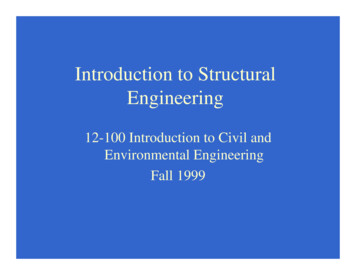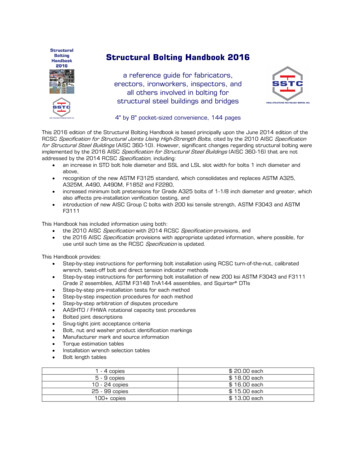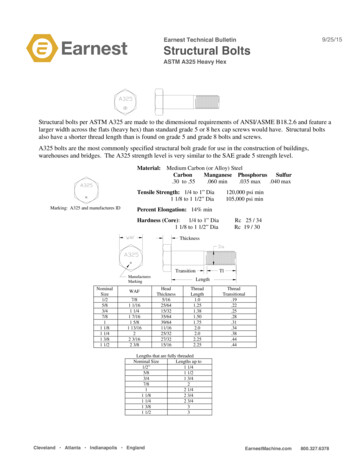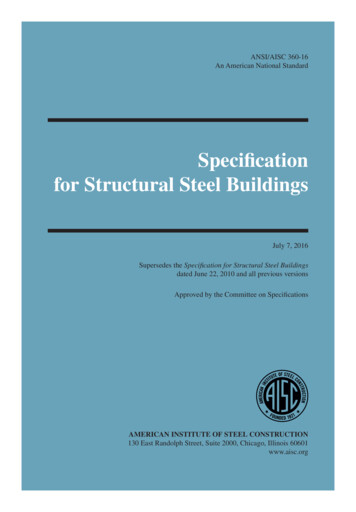
Transcription
StructuralEngineeringHandbookMUSTAFA MAHAMIDEDWIN H. GAYLORD, JR.CHARLES N. GAYLORDFifth Edition2021NewYork Chicago San Francisco AthensMadrid Mexico City Milan New DelhiSingapore Sydney TorontoLondon
Solving for Strain, Stress, and Other Quantities. Dynlimlc Flnlte-ElamentAnalysls. NonllnearFlnlte-ElemmtAnalysls.Verification and Validation Issues and Pitfalls in Finite-Element Analysis. lntrodudlon to Finite Elements for Thermal, Thennomechanlcal,and Other Problems Ref.ranees 126126128128128130131Chapter 4. Computer Applications in Structural EngineeringRaoul Karp, Bulent N. Alemdar, Sam Rubenzer.4.1 lntrodudlon. 4.2 Computer Structural Analysis Simulation 4.3 Strudural Finite Elements.4.4 Foundations.4.5 Verifying Analysis Results 4.6 Building lnfonnation Modeling and Interoperability 4.7 Summary.RetWrences Chapter 5. Earthquake-Resistant Design s. K. Ghosh 5.1 Overview. 5.2 Nature of Earthquake Motion 5.3 Design Phllosophy. 5.4 Seismic O.slgn Requirements of the 2018 IBC/ASCE 7-16.References Chapter 6. Fracture and 6147162s. Kirane, Zdenllc P. Bablnt,J. Emesto lndacochea, Vineeth Kumar Gattu 165PART A CONCRETE AND COMPOSITES.6.1 lntrodudlon to Quaslbrlttle Fradure 6.2 Conaete 6.3 Flber-Relnforced Composites.Ref.ranees 165165166169173PART B STRUCTURAL STEELS 6.4 Fracture of Structural Steels. 6.5 Fatigue of Structural Steels.References 175175182193Chapter 7. Soil Mechanics and Foundations Joseph w. Schulenberg,KrishnaR.Reddy.7.17.27.37.47.SSoil Behavior. Shallow Foundation Analyses Deep Foundations Retaining Strudures. Investigations.7.11 Soil Improvement.7.7 Monitoring.Ref.rences Chapter 8. Design of Structural Steel Members Jay Shen,Bulent Akbas, Onur Seirer, Charlies J. Carter. 8.1 Design of Steel and Composite Memben 8.2 Seismic Design of Steel Members In Moment and Braced Frames 8.3 Conduding Remarks. RetWrences 195195199204210218219221221225225264303303Chapter 9. Design of Cold-Formed Steel Structural MembersNabil A. Rahman, Helen Chen, Cheng Yu. 9.1 Shapes and Applications. 9.2 Materials. 305305306
Chapter6Fracture and FatiguePART ACONCRETE AND COM POSIT ESBYofKEDAR 5. KIRANE Assistant Profeswr Mechanir.al Engineering. Stony Brook Univmi Stony Brook, NewZDENl!K P. BA2ANT McCormick Institute Professor and Walter P. Murphy Professor of Civil andYorkEnvironmental Engineering. Mechanical Engineering and Material Science and Engineering.Northwestern Uni11ersit)I E1/anSton, nlinois6.1INTRODUCTION TO QUASIBRITILE FRACTUREConcrete and fiber-reinforced composite,, are two of the most widelyused structural marerials. Both are composite materials consisting ofmultiple constituents and have a highly heterogeneous microstructure.Concrete typically consists of aggregate bonded by hardened cementpaste while fiber composites typically consist of a weaker matrix materialreinforced by strong fibers, which may be discontinuous or continuous,consisting of parallel fibers of a fabric. The fracturing behavior of thesematerials differs from metals. They exhibit almost no plasticity. Theyfail by propagation of a macrocrack having at its front a fracture processzone (FPZ), which contains microcraclcs and microslips and nonnaDyhas a size not negligible compared to structural dimensions.The fracture propagation starts either from a preexisting macrocrackor by formation of an FPZ in a region with a stress concentration, oftenat the boundary. The large size of the FPZ, which is dictated by material hett:rogeneity and is approximately a constant material property,endows the material with a significant capability to dissipate energy,which can provide certain measure of structural ductility. So, eventhough these materials are colloquiaDy referred to as brittle, in scientificdiscourse they are properly termed Mquasibrittle:" But note that thisterm is relative. When the structure becomes so large that the FPZ sizeis negligible, a quasibrittle structure becomes rittle. Vice versa, whena brittle structure, made, for example, of fine grained mortar, becomessufficiently small its behavior becomes quasibrittle. There are manyquasibrittle materials-aside from concrete and fiber composites, suchas most rocks, coal, wood, sea ice, coarse-grained ceramics, rigid foams,paper, carton, bone, and bio- and bio-inspired materials. 1To assess the strength of structures with cracks, fracture mechanicsmust be used.l Today there are three types of fracture mechanics:(1) linear elastic fracture mechanics (LEFM), which was originated byin 1921 by Griffith 3 and characterizes brittle failure; it deals with sharpcraclcs whose FPZ is negligible compared to structure dimension (e.g.,the FPZ in fatigued steel haa micrometer dimensions). (2) The ductilefracture mechanics, 2 was developed fully during the 1960s, in whichthere is a long and wide plastic (or plastic-hardening) zone in frontof the crack but the FPZ is still negligible; and (3) quasibrittle fracturemechanics,1 there is a large FPZ in front of the crack, with almost noplastic zone surrounding it. The ductile, as well as quasibrittle, fracturemechanics is approximately treated by various adaptations ofLEFM.In LEFM, the crack propagation criterion can be stated eitherin terms of the fracture energy, Gf' which represents the energy requiredto extend the crack by a unit area, or in terms of the critical stressintensity factor, called the fracture toughness, K,. Their relation, dueto Irwin, is(6.1)where, for plane stress, E' B Young's modulus of elasticity and, forplane strain, E' E/(1 - vl) where v is the Poisson's ratio. The craclccan grow and possibly cause structural failure when K becomes equalto[(,.For quasibrittle materials, however, due to the FPZ, a significant partof the structure volume acts nonlinearly, making LEFM inapplicable.A simple but effective treatment of this nonlinearity is the equivalentLEFM approach. 1.2 In this approach, the nonlinear FPZ is accountedfor by assuming that its effect on the compliance and load capacity ofthe structure is essentially the same as if an LEFM sharp crack wereextended, by distance ep roughly into the middle of the FPZ. 1 Thelonger crack, oflength a. a 0 ep where 'J is approximately constant,is called the effective or equivalent craclc (see Fig. 6.1). The remainingtreatment is similar to LEFM, as used for example, for fatigue-embrittledstt:el. The equivalent LEFM can be applied for crack initiation evenwhen only the FPZ. but no actual crack, is as yet present, which is notthe case with LEFM.Some rules have to be introduced to express how the equivalentcraclc extends under increased loads. For instance, the fracture energyG1 for equivalent LEFM (alternately interpreted as the internal materialresistance R to crack growth) is not a constant but varies with the craclclength, becoming a constant for larger crack sizes. The plot of this internal resistance R versus the crack extension Ila from the notch is referredto as the R-curve1.2 (or resistance curve). This curve can be empiricallydett:rmined from lab rests.An important aspect that must be considered is the structure sizeeffect on its nominal strength, defined as aN P,.JA, where P,.,, isthe load capacity (maximum load) and A the structural cross-sectionarea (which can be taken arbitrarily but must be homologous for various sizes). A host of past studies 1-' have established the close interplaybetween failure load, FPZ size, and the resulting scaling in the structuralstrength. 115
CHAPTER SIX166 xFigul't! 6.1 Equivalent LEFM crack.Size effects of two basic simple types can be distinguished. Considerfirst the type I size effect,4 which occurs in unnotched or un-precrackedstructures that fail when a macrocrack initiates from a smooth surfacein the presence of a stress gradient. It is explained by the stress redistribution due to FPZ formation, the equivalent LEFM crack becomingnonzero.5.6 In the absence of the statistical part, which is importantfor very large structures, the size effect on the nominal structurestrength is(6.2)Here D is the structure size, CS0 is the asymptotic strength for a structure of infinite size, 10 is a length constant proportional to the materialcharacteristic length scale, and r is a dimensionless empirical constantwith typical value 1.45.For very large sizes (D "") this equation predicts a vanishing sizeeffect. However, in reality, in structures of sizes much larger than theFPZ, the strength in type I failures follows the Weibull statistical sizeeffect.7 A smooth transition to the statistical size effect can be incorporated in Eq. 6.2 by modifying it to a generalized energetic-statistical sizeeffect5 law as follows:(6.3)Here n is the number of dimensions of the failure mode (1, 2, or 3) andm is the Weibull modulWJ, typically 24 for concrete and 8 to 10 for fibercomposites.8- 10 A best fit of Eq. 6.3 is shown in Fig. 6.2 to a variety oftest data on concrete and composites.The degree ofbrittleneu (opposite of ductility) ia important for theprobabilistic distribution function (pdf) of structural strength and oflifetime under cyclic and static fatigue. For brittle materials, the pdf ofstrength and fatigue lifi:times is of Weibull type, while for ductile materials it is Gaussian (or normal). In the central range both pdfs are hardto distinguish, but the very low failure probability point (Pr 1 ) in theWeibull pdfis almost twice as far from the mean as for the Gaussian [forthe same mean and the typical coefficient of variation of errors (CoV)].For quasibrittle structures, the pdf is a hybrid of both. 11- 13 It consist. ofa Weibull tail grafted on the left onto a Gaussian core. For structuresincluding one or a few FPZs, the grafting point is at P1 - 0.001. Asthe structure size increases, the grafting point moves to the right andwhen the structure volume becomes 105 times the FPZ, the entire pdfbecomes Weibullian. This is important for setting the safety factors fordesign, which should ensure P1 10- S per lifetime (which is about 104times lower than one's probability of dying in a car accident and aboutthe same as the probability of being killed by a lightning).In structures with a large traction-free crack at peak load (or a sharpnotch) the type II size effect is observed.1-'11 14-22 This is a purely deterministic size effect on the mean strength (while material randomnessaffects only the CoV). It becomes the strongest for large sizes and corresponds to LEFM (ie., aN oc D-112 ). As long as the failure modes for different sizes of geometrically scaled structures are also geometrically similar(which is often the case). the strength follows the Baiant size effect lawl-'11(l CSN Bft'-V2J(6.4)Here B is an empirical, dimensionless material constant ft.' is the localtensile strength of material, and D0 is a transitional size proportional tothe material characteristic length scale, which in tum is proportional tothe FPZ size. The size effect factor in Eq. 6.4, proposed to ACI (American Concrete Institute) in 1984, was in 2019 incorporated into the ACIdesign code (ASI Standard 318-2019) for beam shear, punching andstrut-and-tie model.The size effects of types I and II have been observed in concreteand in fiber-reinforced composites, aside from other quasibrittlematerials1-'11 (see Figs. 6.2 and 6.3). Both size effect laws consist of alength scale determined by the FPZ size, which is a material property.This length is essential for realistic mathematical prediction of structurestrength. The rest of thia chapter describes the fracturing behavior ofconcrete and fiber composites under various loading conditions whichleads to the formation of the FPZ. Most of these failure modes arequasibrittle, exhibit the R curve, transitional size effects on strength, andhybrid Gauss-Weibull probability distributions of strength.11.2 CONCRETE4Taata:3 0Nielson 19543 point Wright 19524 point Wright 19521 Inch Waker & Bloem 19572 Inch Waker & Bloem 1957Reagel & Willis 1931Sabnis & Mirza 1979Rokugo 19950Rocco 19954iJ,.0:IC.caa, 2c:D1ij !!!'CLindner 1956- - Staliatical formula, m 24. t fit of type I sizeeffect law10Normalized size100Flguni 6.l Type I size effect (measured fur concrete and composites)'[reproduced with permission from American Concrete Institllte (ACI)].1000Concrete in iu cured form may be treated as isotropic and homogeneous in the macroscopic sense. On the microstructural levd it is highlyheterogeneous, full of cracks of sizes at all scales from the nanoscaleup." Iu mechanical response depends highly on the confinement. Theuniaxial strength in tension, typically 4-5 MPa, is normally 8-10 timesweaker than in compression. This is because the aggregate pieces canwithstand large compressive stresses, but under tension the aggregatecement bond is much weaker.24.2511.2.1Streu-Strain CurwThe typical stress-strain curve ofconcrete24 under uniaxial compressionas well as tension is shown in Fig. 6.4. It consists of two stages-prepeakand postpeak. The initial part is linear elastic. As the load increases,formation of microcracks and frictional microslips induces a prepeaknoalinearity in the stress-strain curve, more pronounced in compression than tension.Beyond the peak, the uniaxial stress decreases gradually at increasing strain, which is called postpeak softening and can be observed in astable manner only in a testing machine with a sufficiently stiff frame.The stability of postpealt testing can be greatly enhanced by controllingsome displacement that is monotonically increasing (e.g., the crackopening displacement). Complete failure corresponds to stress reduction to zero. The area under the stress-strain curve represent. the energydissipated per unit volume.
FRACTURE AND FATIGUE1670.25oTestdata0.00.I:!a -0.25is -0.50 -0.75Q .sz-1 .00 0-0.350.5152(a) 53-0.5 , . . . .01.522.53Log (size D)(b)Flgure&J 1'ype n me df {11) wboD ftberwmpo test clataof.2016 aud (b) concme1'teat dmof.2014[repnidU«d with pcrmill:ian fmm Bltcricr].In rpedme.ns or structuretlarger than a.few FPZt, thepostpealr.1ofte.nlng Is inevl.tably accompanied by locallutton of fracturlng damage into aband of a finite width. w Under unl.uia'I tension, this band forms alonga. plane normal to the loading dirution. as ahown in Fig. 6.5('1); see alsoFig. 6.6(a) for ten.rile fractun: U11der bending. Under uniu:ial amipn:sllon, various flllure medienlsm are poalble depending on the boundarySoftening curveStrainRguni 6.4 Skekh of a typical lllllaial. llntf-"1'alll cuml of OOllGl'ete.conditions. If the ends are sliding, a 8lngle dominmt uial 1plitting crackform where damage localizes along a normal plane due to temile straiNgenmtted. in the latmil dim:tion (perpendicular to the loading direction).The 1plllting.Is cauaed by elaatic Pol88on effect but mainlyinelaatic meclaDlmls Nch u iDcllned slips and weclglng of one aggregtm: between two,11as shown in Fig. 6.s(b) and Fig. 6.6(b). The a:s:ial splitting fracture C'a'll8eSno lliu effect becauae no strain energy is R1eased. from outaide the band.i.aBut lfone or bod!. en& are fb:ed. a compraslon-mear failure band fonmwhere the damage localizei along one or two Inclined planes u shown InFig. 6.5(') and (d).This failure llCtlla1ly comi8ts ofparalld small a:da'l 8}llitting aac.k.s arranged into an inclined band and does awae a size effect.1DD(a)1}(b)(C)D(d)Rture 6.S {11) Damage lcx;allzat!on a.Dder 1llliu:lal. tutlon. {b) Ami. llttiDg fAl!u.re 'Glider 1llllu1alcompn!llion with aJidina enda. (c} ComprHrion·1h.ear &mm! under aniaxial compru.lion with one end. fiud.(d) CompteHloD.-ahear failure Wider lllllulal oomprealon w:lth both ends fixcd.1
1.CHAPTER SIX(a)(b)fltlure 6.6 (") 'n:b.lllc liallatc In amctetc unda thn:e-poiol bending. (lo) Axial 'Pllllintlcomp m failuze of a qllnd.er [rcprodu.ced with pcrmllllon from .!ltmcr].6.2.2 MuldPl I fl'MtUNIn majority of ttru.ctura. con ii subjected to rmdtiaxtal ltrea.The biuial :0111ptafion strength of concr is higher than uniaxial.especially in the prmence of end rellrainb. Biaxial tenaion makeslittle difl'uence for ltmlgth from unluial Under combined. tendoll andcompremon, concrdl: ii the -uat. The &!lure under b.luial low alsoOQ;UQ by loc3lizmon along prckrred orientmom. typi.cally perpendicular to the muimum principll temile .txeN,Z7 and aJ.o abihib li2e eft'ect.t.niulal c:oinpreadve loading of concrete can cause a major lncreuein ih strength. Under bydromtic a mpreMon u wdl u uniax1al compreaive ttrain with virtually rigid con5nement, ccmaete Det'eT RU. andonly densifies by pore aill.ap1e. The postpeak bdurrior varies dramati-c:allr depending on the degree of con&ement. Inaeulng confinementfrom nOJ1e, the .respo!Ue becomes iDcreuiDgly ductile and Cftl1tllallymtchet from aofteniDg to hardenlnt u lb.own 1n F1g. 6.7. Atthe micro«ale, frictional llip becomes dominant cm r microaacking.atruc:tural strength under monotcmlc as well u cycl1c load!Jlg. Thua,.reinforced concrete 13 generally much ie. temltive to filtlgue thanmetab. N(VCit}ideN, like in all materW., cracb grow under cyclic atwell u awitained loada, e&111ed, for eumple, by 1raffic, wind, rotatingmachinery, or earthquaku.ll This can be quite Important for somesituatlorui (plaln concrete, zone of low reinforcement, developmentof ac:euive crack width allowing ingreu of corroaive agents, etc.).ID conaete la markedly differeat from metaJs.1.2'-SO Fatigueoccurs by actiYation of pRailtlng .mkroc:raclai and mic:rotllps withinthe c:ydlc FPZ. Since limilar microcncb allo form during monotonicloading. the &n,ue aack inufu:e1 in conaete have no peculiar topography unllb metalt, and are huda to dUtinguiah viaually. The onlydifference la that the cyclic FPZ la mWler in me compared to them011otonlc: FPZ. '1.SlThe fatigue beharior of cont.rm: dependt on the strength of thematerial, the lo (mmgnitude, wueform, frequency; etc.) and theenvironmental conditions. Conaete undergoes &tlgue under bothtmllon uid comJ'ftAIOll uid In fa.et compreaton fatigue ba.uds cangrvw tranPerlely to compr strul.29 At the .microstructure level.fatigue consitta of irrennible microcnckiug · The load dilplacement curve ahJbii:. fur each unload-relDld cycle a hylteresla loop(Fig. 6.8) whose area equab the energy dUslpated in that cycle. Theelamc modulwi degnde1 gradually with increasing ind.utic; deformation in each cycle. The cyclic load-dilplacement curve is enveloped bythe monotonic one.ss-ssStrain,.,,. u{ h6.2.JSdiCl!Qltk beh.&11« of concme 11.Ddcr ClOnftned compm11 mlndk:aka unluial ).Fetigu9Ideally, the strength of rdnfor«d cOJ1crete ltrUcturcs depends on steelbar , and even though luge Qirllne c:racb, tr&vening 5-0 to 80 percentaf the 1truc:tun width, typically dewlop. they haTe little effect onDisplacementFlgu. 6.1Schemalic al ·reload. hyltcre&ls lo0pt Ill COllCfete t.i.tipe. 'o
FRACTURE AND FATIGUE6.2.4 Dellgn far Altfgue(6.5}" · - 1-PCl-R)logNJ.whidi npmaits a simplified. total life ipproac:h and does not considerthe pr:opagalion of damage; a.,, it the maximum s!R!1 level of thecyclic loadin.g. f. b the oomp.re11lve strength of concrete. R is the loadratio (a-1a-J, N is the number of cycles to failure and Pis an emplrl :al material COllnant whose typi :al value is 0.068S. S« Fif. 6.9 for atypi :al S-N curve for plain concrete.There are alternate expre.Wons fur fatigue lif.etima in various designcodes:!*(i) For pure compression8IogN y cs,--1 iflogN 81logN 8 Sln(lO)(Yy- I. y(6.6)-S,.-)log(s,.,.-s,,ml!!)iflogN 8y -s .-0.45 us., -;and Sl l.8Sc,.m1n -0.3s!.w, .mlala .-1 -·-· Sf,;.i. ' . - la.!:!!!:!!.If,;.i.(6.7}(ii) For compre.Won-tenalon witha., 0.G261cs .-I.logN 9(1-S,,. )(6.8)The fatigue reference compressive strength f.At has been inttodw:edto take into account the increase of &tigue Wltitivity of COllcretc with(6.9)Here .P.(t) is an emplrl :al coeftklent wbic:h. d.epe.ads on the age t ofconcrete (in days} when htigue loading &ta11s, and P,,. Is anotherempirical coefficient whic:h takes into account the effi:ct of high mean during loading and lb typical value it 0.85 when all 1he fl:res.1ellare expRMed In .MPa.(iii) For pure wmion and tension-compression with a- 0.0261 ,.-I l"d;,-1(6.10)OQ;)SmaxT: C(AK)"'{6.11)The typical value of aponent m for concrete b 8 to 12,41 which ismuc:h higher than what I aeen fur metal (2 to 4). The codlic:ient Clw been found" to be sensitive to environmental conditions (suchas temperat:un), loading frequency a1 well u the load ratio R. Undertension-tension fiiligue, a distlnct llze effect lw !Wo been nportedIn the Paris law fur concrete which appears to affect the coefficient Cbut not the aponent m.sui Th1s makes the Par! law plou of concretespecimens of different sizes appear a1 parallel lines spaced apart onlog-log scale. It it expected that tlm tlze effect would vanish for verylarge mes but providing direct aperimental evidence is difficult aiDcethis Is beyond most lab-sc:ale specimen size. (u the cyt1k FPZ is about1 foot long). Thi experimental observation also implies a ngnmcantme effect in the fatigue lifetimet of amcrete s!J:uctw:a. The size effectill fatigue of concrete b a topic of ongoing reaearch. 11-'16.3 FllER·REINFORCED COMPOSMSand, moat lmpol'Wlt light weight, ti.ber-reinforced composites areJ .r- 0.85,S.,Ct)P .-.f. (1- )0.8 cDue to their lti1fne11, atrength. corrosion reslatanc.e, fatigue reatstance.increasing compnmive llrength. hill given bylogN 12(1-Sd-) where S.,,-att.- I the mu:lmwn tenale suus and ft lsthe .miD.lmumtensile strength. Thus. Eq. 6.10 pruaibes the fatigue lifeunder tension to depend only on the muimum 11.n!H level. Under variable amplitude loading. the Miner rulel'I may be applied.The total life approach 18 much a!mpler but coneervattve and highlyempirical The Jen conse.rvatl.ve, damage-tolm111t approach is U uallynot pursued for cone.me, although it is ponible. This it similarto metals, fatigue cracb in a ncrete aho grow acrording to the Parislaw.,. Thie hu long been conaldered u an empirical law relating therate of crack growth per cycle, daldN, to the amplitude llK. of the stressintensity factor K through a power law (although recently it was derivedCrom the activation encqy-am!J:olled breakage rate of intaatomicbonds"' ). The Paria law uadtHereWidely acapted. lm the fatigue usemnent of concrete (under uniu:ialcompression, without stre.n revenal) it Che Au-Jakobsen equation for the ao-caI!ed S-N curve (stttas S va. number N of cycles)1ff0.1widely used in aerospace, nawl. and automotive engineering. They areaho becoming increuingly prevalent in infrastructure applic:ation1malnly for structural upgrades such u rapid repail:, rehabilitation, andseismic retrofitting of alrtlng structum.Thdr basic const!tuems ue sJw or cubon fiben and polymermalrix. The tibc:n cany me.It of the load and provide most of die stiff.nest and tensile stre.nglh of the material. The matrix and the fiber-matrixInterface bond coll.ttlbute strongly to the composlte's shear strength,tranmne strength. and, also. fU1gue mength.ea The ma1r1x transfers theload between the individual tiben and acts as the agmt holding die 6berstructure in place. Since Che fibers have specific dlrectlonality, a compositela alwayii anlaotrcplc (or orthotropic) at the maaoscale, unlike concrete,which is esse.atl.ally .lsotropl"' In structural applkatl.ons, the mlsotropy Is mitigated by unng quasi-iaoll'opic :Cl!Jlpotitc lay-ups consmmg ofindividual laymi (or pn:-J?RP) oriented in variollll directiom.Comp undergo fracture through a variety of mec:hanWmdepending on the applied load and Its angle with the fl.ber direction.The is progmsivc in nature and occurs at a number oflengthscales, from the barely observable phenomenon of tiber-malrix debonding on the microacale to the matrix cracldng, flber breaking anddelaml.nation43 on the maaoscale. Often one filil'l11'e mechanism trigger some others, depending o.n the specific loading 1 :enario. Numerical modeling and prediction of failure of compo1itll1 under multiuialloads b not a rtraightforward task.6.11.1 Langltudln.1111 Fl'llc:tuN0.6 .1.00E 041.00E OS1.00E 06Number at cycles to fallureRguN6.t S·N c.arw fortypical.Flaln C O'Dctde (camprcl5!011)97 (reptodu.c:cd.with permla!on from Amertca11 Conuete Wtl!Ute (AC!)).When the applied load is tensile, in-plane and aligned with the tibers,the dominant mode of failure ls tlber breaking. The longitudinal temllestrength of the composite lam!na Is governed by the tensile attengthof flbers. Ideally. if all the fiben had equal strength. they would breaksimultaneously when the applied load beame equal to their strength.However, ln reality, the fiben have a strength distribution. So, typlcaI!y,the weakest fil en fail 1lnt. The stms then gets redimibuted to adjacent
170CHAPTER SIX6ber. whic;h makes them more su.sceptible to failure. This usu.allyaho triggerl other f'ailure modes ruc:h u localiud malrilt shear failurearound the Bber breab and Bber-matrh. debond!ng. Eventually theadjacent Bbers break. and the mialler c.raclcs merge to produce one largecreck.42 ropagares to cawse the Dnal. Wlw:e, u shown in Fig. 6.lO(o). At the end, additional mechanisms, such u Bber pullout, also appear [see Fig. 6.U(o)].In the 19608,, stable measumnent of postpeak in conc:rete and roCk wumade pouible by the disarm:y thll the tating &ame had to be an orderof magnitude der 1han previolllly wed, and sblbility of test wa.s furtherhelped by developillg fut aervo-cantrol and by contraDing the test by acrack mouth. or crack tip gauge.51 However, fur composite it has notwmk Ulltil 2016 when it wu found that the grips (or 6xt:ures) far tms:ileloading «.fracture tests of supplied by manu&.cturet were futootoft andllgbt (note that no such grips are needed forconaeteslncethe 'J)CIC1men I
Structural Engineering Handbook MUSTAFA MAHAMID EDWIN H. GAYLORD, JR. CHARLES N. GAYLORD Fifth Edition NewYork Chicago San Francisco Athens London Madrid Mexico City Milan New Delhi Singapore Sydney Toronto . Design of Structural Steel Mem










